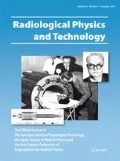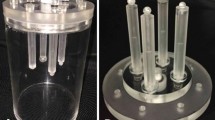Abstract
In this study, we aimed to develop a hybrid method for automated detection of high-uptake regions in the breast and axilla using dedicated breast positron-emission tomography (db PET) and whole-body PET/computed tomography (CT) images. In our proposed method, high-uptake regions in the breast and axilla were detected using db PET images and whole-body PET/CT images. In db PET images, high-uptake regions in the breast were detected using adaptive thresholding technique based on the noise characteristics. In whole-body PET/CT images, the region of the breast that includes the axilla was first extracted using CT images. Next, high-uptake regions in the extracted breast region were detected on the PET images. By integration of the results of the two types of PET images, a final candidate region was obtained. In the experiments, the accuracy of extracting the region of the breast and detection ability was evaluated using clinical data. As a result, all breast regions were extracted correctly. The sensitivity of detection was 0.765, and the number of false positive cases were 1.8, which was 30% better than those on whole-body PET/CT alone. These results suggested that the proposed method, combining the two types of PET images is effective for improving detection performance.










Similar content being viewed by others
References
Breast cancer: facts and figures 2017–2018. American Cancer Society. 2017. https://www.cancer.org/content/dam/cancer-org/research/cancer-facts-and-statistics/breast-cancer-facts-and-figures/breast-cancer-facts-and-figures-2017-2018.pdf. Accessed 21 Jan 2019.
Vercher-Conejero JL, Pelegrí-Martinez L, Lopez-Aznar D, Cózar-Santiago Mdel P. Positron emission tomography in breast cancer. Diagnostics (Basel). 2015;5:61–83.
Hosono M, Saga T, Ito K, Kumita S, Sasaki M, Senda M, Hatazawa J, Watanabe H, Ito H, Kanaya S, Kimura Y, Saji H, Jinnouchi S, Fukukita H, Murakami K, Kinuya S, Yamazaki J, Uchiyama M, Uno K, Kato K, Kawano T, Kubota K, Togawa T, Honda N, Maruno H, Yoshimura M, Kawamoto M, Ozawa Y. Clinical practice guideline for dedicated breast PET. Ann Nucl Med. 2014;28:597–602.
Miyake KK, Matsumoto K, Inoue M, Nakamoto Y, Kanao S, Oishi T, Kawase S, Kitamura K, Yamakawa Y, Akazawa A, Kobayashi T, Ohi J, Togashi K. Performance evaluation of a new dedicated breast PET scanner using NEMA NU4-2008 standards. J Nucl Med. 2014;55:1198–203.
García Hernández T, Vicedo González A, Ferrer Rebolleda J, Sánchez Jurado R, Roselló Ferrando J, Brualla González L, Granero Cabañero D, Del Puig Cozar Santiago M. Performance evaluation of a high resolution dedicated breast PET scanner. Med Phys. 2016;43:2261–72.
Teixeira SC, Rebolleda JF, Koolen BB, Wesseling J, Jurado RS, Stokkel MP, Del Puig Cózar Santiago M, van der Noort V, Rutgers EJ, Valdés Olmos RA. Evaluation of a hanging-breast PET system for primary tumor visualization in patients with stage I-III breast cancer: comparison with standard PET/CT. Am J Roentgenol. 2016;206:1307–14.
Iima M, Nakamoto Y, Kanao S, Sugie T, Ueno T, Kawada M, Mikami Y, Toi M, Togashi K. Clinical performance of 2 dedicated PET scanners for breast imaging: initial evaluation. J Nucl Med. 2012;53:1534–42.
Nishimatsu K, Nakamoto Y, Miyake KK, Ishimori T, Kanao S, Toi M, et al. Higher breast cancer conspicuity on db PET compared to WB-PET/CT. Eur J Radiol. 2017;90:138–45.
Fujita H, Uchiyama Y, Nakagawa T, Fukuoka D, Hatanaka Y, Hara T, Lee GN, Hayashi Y, Ikedo Y, Gao X, Zhou X. Computer-aided diagnosis: the emerging of three CAD systems induced by Japanese health care needs. Comput Methods Programs Biomed. 2008;92:238–48.
Teramoto A, Fujita H, Takahashi K, Yamamuro O, Tamaki T, Nishio M, Kobayashi T. Hybrid method for the detection of pulmonary nodules using positron emission tomography/computed tomography: a preliminary study. Int J Comput Assist Radiol Surg. 2014;9:59–69.
Teramoto A, Fujita H, Yamamuro O, Tamaki T. Automated detection of pulmonary nodules in PET/CT images: ensemble false-positive reduction using a convolutional neural network technique. Med Phys. 2016;43:2821–7.
Cheng HD, Shi XJ, Min R, Hu LM, Cai XP, Du HN. Approaches for automated detection and classification of masses in mammograms. Pattern Recognit. 2006;39:646–68.
Yu S, Guan L. A CAD system for the automatic detection of clustered microcalcifications in digitized mammogram films. IEEE Trans Med Imaging. 2000;19:115–26.
Dong M, Lu X, Ma Y, Guo Y, Ma Y, Wang K. An efficient approach for automated mass segmentation and classification in mammograms. J Digit Imaging. 2015;28:613–25.
Rangayyan RM, Banik S, Chakraborty J, Mukhopadhyay S, Desautels JE. Measure of divergence of oriented patterns for the detection of architectural distortion in prior mammograms. Int J Comput Assist Radiol Surg. 2013;8:527–45.
Yoshikawa R, Teramoto A, Matsubara T, Fujita H. Automated detection of architectural distortion using improved adaptive Gabor filter. In: Proceedings of IWDM. 2014. pp. 606–11.
Ikedo Y, Fukuoka D, Hara T, Fujita H, Takada E, Endo T, Morita T. Development of a fully automatic scheme for detection of masses in whole breast ultrasound images. Med Phys. 2007;34:4378–88.
Cheng HD, Shan J, Ju W, Guo Y, Zhang L. Automated breast cancer detection and classification using ultrasound images: a survey. Pattern recognit. 2010;43:299–317.
Nie K, Chen JH, Chan S, Chau MK, Yu HJ, Bahri S, Tseng T, Nalcioglu O, Su MY. Development of a quantitative method for analysis of breast density based on three-dimensional breast MRI. Med Phys. 2008;35:5253–62.
Agner SC, Soman S, Libfeld E, McDonald M, Thomas K, Englander S, Rosen MA, Chin D, Nosher J, Madabhushi A. Textural kinetics: a novel dynamic contrast-enhanced (DCE)-MRI feature for breast lesion classification. J Digit Imaging. 2011;24:446–63.
Minoura N, Teramoto A, Takahashi K, Yamamuro O, Nishio M, Tamaki T, Fujita H. Preliminary study on an automated extraction of breast region and automated detection of breast tumors and axillary metastasis using PET/CT images. Med Imaging Technol. 2017;35:158–66.
Tanaka E, Kudo H. Optimal relaxation parameters of DRAMA (dynamic RAMLA) aiming at one-pass image reconstruction for 3D-PET. Phys Med Biol. 2010;55:2917–38.
Keyes JW. SUV: standard uptake or silly useless value? J Nucl Med. 1995;36:1836–9.
Li Q, Sone S, Doi K. Selective enhancement filters for nodules, vessels, and airway walls in two- and three-dimensional CT scans. Med Phys. 2003;30:2040–51.
Vranjesevic D, Schiepers C, Silverman DH, Quon A, Villalpando J, Dahlbom M, Phelps ME, Czernin J. Relationship between 18F-FDG uptake and breast density in women with normal breast tissue. J Nucl Med. 2003;44:1238–42.
Funding
The present research was supported in part by a Grant-in-Aid for Scientific Research on Innovative Areas (#26108005), MEXT, Japan.
Author information
Authors and Affiliations
Corresponding author
Ethics declarations
Ethical approval
All procedures in studies involving human participants were performed in accordance with the ethical standards of the institutional and/or national research committee and with the 1964 Helsinki Declaration and its later amendments or comparable ethical standards.
Research involving human participants and animals
The present article does not contain any studies done on animals performed by any of the authors.
Informed consent
Patient agreements were obtained given the condition that all data were anonymized.
Additional information
Publisher's Note
Springer Nature remains neutral with regard to jurisdictional claims in published maps and institutional affiliations.
About this article
Cite this article
Minoura, N., Teramoto, A., Ito, A. et al. A complementary scheme for automated detection of high-uptake regions on dedicated breast PET and whole-body PET/CT. Radiol Phys Technol 12, 260–267 (2019). https://doi.org/10.1007/s12194-019-00516-8
Received:
Revised:
Accepted:
Published:
Issue Date:
DOI: https://doi.org/10.1007/s12194-019-00516-8




